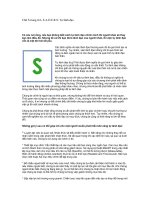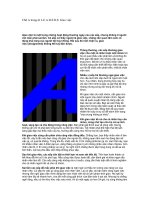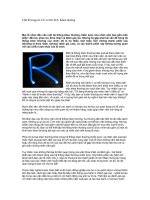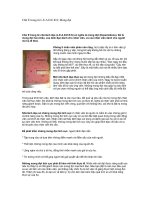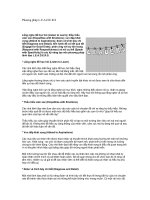NLI - CCIE R&S - Practice Lab - EIGRP
Bạn đang xem bản rút gọn của tài liệu. Xem và tải ngay bản đầy đủ của tài liệu tại đây (274.93 KB, 39 trang )
CCIE PRACTICE LAB: EIGRP
WRITTEN
BY :
ASHWIN KOHLI
CCIE
# 8877
CCIE Practice Lab: EIGRP
Ashwin Kohli, CCIE #8877
Copyright © 2004 Netcg, Inc.
Published by:
Network Learning Inc.
1997 Whitney Mesa Dr.
Henderson, LV 89014 USA
All rights reserved. No part of this book may be reproduced or transmitted in any form or by any means,
electronic or mechanical, including photocopying, recording, or by any information storage and retrieval
system, without written permission from the publisher, except for the inclusion of brief quotations in a
review.
Printed in the United States of America
Warning and Disclaimer
This book contains a practice lab and step-by-step instructions on how to complete the practice lab. Every
effort has been made to make this book as complete and as accurate as possible, but no warranty or fitness
is implied.
The information is provided on an “as is” basis. The author, Netcg, Inc. shall have neither liability nor
responsibility to any person or entity with respect to any loss or damages arising from the information
contained in this book.
The opinions expressed in this book belong to the authors and are not necessarily those of Network
Learning Inc.
Trademark Acknowledgments
All terms mentioned in this book that are known to be trademarks or service marks have been appropriately
capitalized. Netcg, Inc. or Network Learning, Inc. cannot attest to the accuracy of this information. Use of
a team in this book should not be regarded as affecting the validity of any trademark or service mark.
Feedback Information
At Network Learning Inc., our goal is to create in-depth technical books of the highest quality and value.
Each book is crafted with care and precision, undergoing rigorous development that involves the unique
expertise of members from the professional technical community.
Readers’ feedback is a natural continuation of this process. If you have any comments regarding how we
could improve the quality of this book, or otherwise alter it to better suit your needs, you can contact us
through email at Please make sure to include the book title in your message.
We greatly appreciate the assistance.
EIGRP
3
EIGRP
4
ABOUT THE AUTHOR
ASHWIN KOHLI, Ashwin Kohli is a dual CCIE #8877 (Routing/Switching and
Security). He is currently a Global Architect for one of the top three financial
companies, and is responsible for architecting enterprise solutions. He has
worked at many of the top financial companies over the last 10 years. Ashwin
also holds the CCNP®, CCDP ® and a BSc in Computer Science & Accounting
form Manchester University, United Kingdom. He has more than 10 years
experience in Cisco® networking and security including planning, designing,
implementing, and troubleshooting enterprise multi-protocol networks. Ashwin
also writes Cisco® training material for Network Learning, Inc.
.
EIGRP
5
T ABLE OF C ONTENTS
EIGRP..................................... ........................................................ ...................... 6
1.0
Basic Configuration ........................................................ ............................ 6
ANSWER ........................................................ ........................................... 7
2.0
Route summarization ............................................................. ....................9
ANSWER ........................................................ ......................................... 10
3.0
EIGRP – Route authentication - Plain Text.................................................... 13
ANSWER ........................................................ ......................................... 14
4.0
MD5 route authentication ................................................... ...................... 16
ANSWER ........................................................ ......................................... 17
5.0
Rotating keys for route authentication...................................................... 19
Lab Setup................................................. ............................................... 19
ANSWER ........................................................ ........................................ 20
6.0
EIGRP - Split-horizon ........................................................ ....................... 23
ANSWER ........................................................ ......................................... 24
7.0
EIGRP – Passive Interface......................................................... ..............2 8
ANSWER ........................................................ ......................................... 29
8.0
EIGRP - Advertising a Default Route ....................................................... 32
ANSWER ........................................................ ........................................ 33
9.0
EIGRP - Route filtering....................... ...................................................... 36
ANSWER ........................................................ ......................................... 37
EIGRP
6
EIGRP
1.0
BASIC C ONFIGURATION
EIGRP 100
137.1.200.1
Router1
1.
2.
3.
4.
5.
137.1.200.2
Frame Relay Cloud
Configure EIGRP process 100 between Router1 and Router2.
Ensure VLAN 22 and VLAN 11 are included in the EIGRP routing process.
Log any changes in EIGRP.
Do not summarize the routes.
Test your configuration by pinging each of the VLANs.
Router2
EIGRP
7
ANSWER
Router1
Interface f0/0
Ip address 137.1.1.1 255.255.255.0
interface s0/0
ip address 137.1.200.1 255.255.255.0
encapsulation frame-relay
no frame-relay inverse-arp
frame-relay map Ip 137.1.200.2 101 broadcast
!
Router eigrp 100
No auto-summary
Eigrp log-neighbor-changes
Network 137.1.200.0 0.0.0.255
Network 137.1.1.0 0.0.0.255
Router2
Interface e0/0
Ip address 137.1.2.2 255.255.255.0
interface s0/0
ip address 137.1.200.2 255.255.255.0
encapsulation frame-relay
no frame-relay inverse-arp
frame-relay map Ip 137.1.200.1 110 broadcast
Router eigrp 100
No auto-summary
Eigrp log-neighbor-changes
Network 137.1.200.0 0.0.0.255
Network 137.1.2.0 0.0.0.255
The following shows what happens when an EIGRP relationship has been formed between the
two routers.
!Router1 logs when the neighbor relationship with Router2 comes up
router1#
*Mar 1 10:40:14.453 UTC: %DUAL-5-NBRCHANGE: IP-EIGRP(0) 100: Neighbor 137.1.200
.2 (Serial0/0) is up: new adjacency
!Router2 logs when the neighbor relationship with Router1 comes up
router2#
*Mar 1 10:39:11.447 UTC: %DUAL-5-NBRCHANGE: IP-EIGRP(0) 100: Neighbor 137.1.200
.1 (Serial0/0) is up: new adjacency
!Router1 has an EIGRP neighbor relationship with Router2
!Router2 has an EIGRP neighbor relationship with Router1
!Router1’s
router1#sh
Codes: C D -
routing table includes VLAN 22. It has learnt this via EIGRP from Router2
ip route
connected, S - static, R - RIP, M - mobile, B - BGP
EIGRP, EX - EIGRP external, O - OSPF, IA - OSPF inter area
EIGRP
8
N1 - OSPF NSSA external type 1, N2 - OSPF NSSA external type 2
E1 - OSPF external type 1, E2 - OSPF external type 2
i - IS-IS, L1 - IS-IS level-1, L2 - IS-IS level-2, ia - IS-IS inter area
* - candidate default, U - per-user static route, o - ODR
P - periodic downloaded static route
Gateway of last resort is not set
C
C
D
137.1.0.0/24 is subnetted, 3 subnets
137.1.200.0 is directly connected, Serial0/0
137.1.1.0 is directly connected, FastEthernet0/0
137.1.2.0 [90/2195456] via 137.1.200.2, 00:00:16, Serial0/0
!Router2’s routing table includes VLAN 11. It has learnt this via EIGRP from Router1
router2#sh ip route
Codes: C - connected, S - static, R - RIP, M - mobile, B - BGP
D - EIGRP, EX - EIGRP external, O - OSPF, IA - OSPF inter area
N1 - OSPF NSSA external type 1, N2 - OSPF NSSA external type 2
E1 - OSPF external type 1, E2 - OSPF external type 2
i - IS-IS, L1 - IS-IS level-1, L2 - IS-IS level-2, ia - IS-IS inter area
* - candidate default, U - per-user static route, o - ODR
P - periodic downloaded static route
Gateway of last resort is not set
C
D
C
137.1.0.0/24 is subnetted, 3 subnets
137.1.200.0 is directly connected, Serial0/0
137.1.1.0 [90/2172416] via 137.1.200.1, 00:00:29, Serial0/0
137.1.2.0 is directly connected, Ethernet0/0
!Router1’s EIGRP topology database contains VLAN22 information
router1#sh ip eigrp topology
IP-EIGRP Topology Table for AS(100)/ID(137.1.200.1)
Codes: P - Passive, A - Active, U - Update, Q - Query, R - Reply,
r - reply Status, s - sia Status
P 137.1.200.0/24, 1 successors, FD is 2169856
via Connected, Serial0/0
P 137.1.1.0/24, 1 successors, FD is 28160
via Connected, FastEthernet0/0
P 137.1.2.0/24, 1 successors, FD is 2195456
via 137.1.200.2 (2195456/281600), Serial0/0
EIGRP
2.0
9
ROUTE SUMMARIZATION
EIGRP 100
137.1.200.1
Router1
1.
2.
3.
4.
5.
137.1.200.2
Frame Relay Cloud
Router2
Configure EIGRP process 100 between Router1 and Router2.
Ensure VLAN 22 and VLAN 11 are included in the EIGRP routing process.
Create the following loopbacks on Router1:
a. Loopback address 1 - 172.16.32.0 /24
b. Loopback address 2 172.16.33.0 /24
c. Loopback address 3 172.16.48.0 /24
d. Loopback address 4 172.16.58.0 /24
Summarize the above routes so that only a single route appears in Router2.
Test your configuration by pinging each of the loopback address from Router2 and ensure only a single
summarized route appears in that router.
EIGRP
ANSWER
Router1
Interface loopback 1
Ip address 172.16.32.1 255.255.255.0
!
interface loopback 2
ip address 172.16.33.1 255.255.255.0
!
interface loopback 3
ip address 172.16.48.1 255.255.255.0
!
interface loopback 4
ip address 172.16.58.1 255.255.255.0
!
Interface f0/0
Ip address 137.1.1.1 255.255.255.0
interface s0/0
ip address 137.1.200.1 255.255.255.0
encapsulation frame-relay
no frame-relay inverse-arp
frame-relay map Ip 137.1.200.2 101 broadcast
ip summary-address eigrp 100 172.16.32.0 255.255.224.0
!
Router eigrp 100
No auto-summary
Eigrp log-neighbor-changes
Network 137.1.200.0 0.0.0.255
Network 137.1.1.0 0.0.0.255
Network 172.16.32.0 0.0.0.255
Network 172.16.33.0 00.0.0.255
Network 172.16.48.0 0.0.0.255
Network 172.16.58.0 0.0.0.255
Router2
Interface e0/0
Ip address 137.1.2.2 255.255.255.0
interface s0/0
ip address 137.1.200.2 255.255.255.0
encapsulation frame-relay
no frame-relay inverse-arp
frame-relay map Ip 137.1.200.1 110 broadcast
Router eigrp 100
No auto-summary
Eigrp log-neighbor-changes
Network 137.1.200.0 0.0.0.255
Network 137.1.2.0 0.0.0.255
The following shows the Routing tables before the Route summarization is carried out
!Router1 is advertising all the loopbacks to Router2
router1#sh ip route
Codes: C - connected, S - static, R - RIP, M - mobile, B - BGP
D - EIGRP, EX - EIGRP external, O - OSPF, IA - OSPF inter area
N1 - OSPF NSSA external type 1, N2 - OSPF NSSA external type 2
E1 - OSPF external type 1, E2 - OSPF external type 2
i - IS-IS, L1 - IS-IS level-1, L2 - IS-IS level-2, ia - IS-IS inter area
* - candidate default, U - per-user static route, o - ODR
P - periodic downloaded static route
Gateway of last resort is not set
137.1.0.0/24 is subnetted, 3 subnets
10
EIGRP
C
C
D
C
C
C
C
137.1.200.0 is directly connected, Serial0/0
137.1.1.0 is directly connected, FastEthernet0/0
137.1.2.0 [90/2195456] via 137.1.200.2, 00:00:18, Serial0/0
172.16.0.0/24 is subnetted, 4 subnets
172.16.58.0 is directly connected, Loopback4
172.16.48.0 is directly connected, Loopback3
172.16.32.0 is directly connected, Loopback1
172.16.33.0 is directly connected, Loopback2
!Router2 is receiving all the individual routes from Router2
router2#sh ip route
Codes: C - connected, S - static, R - RIP, M - mobile, B - BGP
D - EIGRP, EX - EIGRP external, O - OSPF, IA - OSPF inter area
N1 - OSPF NSSA external type 1, N2 - OSPF NSSA external type 2
E1 - OSPF external type 1, E2 - OSPF external type 2
i - IS-IS, L1 - IS-IS level-1, L2 - IS-IS level-2, ia - IS-IS inter area
* - candidate default, U - per-user static route, o - ODR
P - periodic downloaded static route
Gateway of last resort is not set
C
D
C
D
D
D
D
137.1.0.0/24 is subnetted, 3 subnets
137.1.200.0 is directly connected, Serial0/0
137.1.1.0 [90/2172416] via 137.1.200.1, 00:00:03, Serial0/0
137.1.2.0 is directly connected, Ethernet0/0
172.16.0.0/24 is subnetted, 4 subnets
172.16.58.0 [90/2297856] via 137.1.200.1, 00:00:03, Serial0/0
172.16.48.0 [90/2297856] via 137.1.200.1, 00:00:03, Serial0/0
172.16.32.0 [90/2297856] via 137.1.200.1, 00:00:03, Serial0/0
172.16.33.0 [90/2297856] via 137.1.200.1, 00:00:03, Serial0/0
!Router2’s EIGRP topology database also contains all the individual routes
router2#sh ip eigrp topology
IP-EIGRP Topology Table for AS(100)/ID(137.1.200.2)
Codes: P - Passive, A - Active, U - Update, Q - Query, R - Reply,
r - reply Status, s - sia Status
P 137.1.200.0/24, 1 successors, FD is 2169856
via Connected, Serial0/0
P 172.16.58.0/24, 1 successors, FD is 2297856
via 137.1.200.1 (2297856/128256), Serial0/0
P 137.1.1.0/24, 1 successors, FD is 2172416
via 137.1.200.1 (2172416/28160), Serial0/0
P 137.1.2.0/24, 1 successors, FD is 281600
via Connected, Ethernet0/0
P 172.16.48.0/24, 1 successors, FD is 2297856
via 137.1.200.1 (2297856/128256), Serial0/0
P 172.16.32.0/24, 1 successors, FD is 2297856
via 137.1.200.1 (2297856/128256), Serial0/0
P 172.16.33.0/24, 1 successors, FD is 2297856
via 137.1.200.1 (2297856/128256), Serial0/0
The following shows the Routing tables after the Route summarization is carried out
!Router1 is advertising all the loopbacks to Router2 and the summarized route
router1#sh ip route
Codes: C - connected, S - static, R - RIP, M - mobile, B - BGP
D - EIGRP, EX - EIGRP external, O - OSPF, IA - OSPF inter area
N1 - OSPF NSSA external type 1, N2 - OSPF NSSA external type 2
E1 - OSPF external type 1, E2 - OSPF external type 2
i - IS-IS, L1 - IS-IS level-1, L2 - IS-IS level-2, ia - IS-IS inter area
* - candidate default, U - per-user static route, o - ODR
P - periodic downloaded static route
Gateway of last resort is not set
C
137.1.0.0/24 is subnetted, 3 subnets
137.1.200.0 is directly connected, Serial0/0
11
EIGRP
C
D
C
C
C
D
C
137.1.1.0 is directly connected, FastEthernet0/0
137.1.2.0 [90/2195456] via 137.1.200.2, 00:07:54, Serial0/0
172.16.0.0/16 is variably subnetted, 5 subnets, 2 masks
172.16.58.0/24 is directly connected, Loopback4
172.16.48.0/24 is directly connected, Loopback3
172.16.32.0/24 is directly connected, Loopback1
172.16.32.0/19 is a summary, 00:08:45, Null0
172.16.33.0/24 is directly connected, Loopback2
!Router2 is receiving only the summarized route from Router2
router2#sh ip route
Codes: C - connected, S - static, R - RIP, M - mobile, B - BGP
D - EIGRP, EX - EIGRP external, O - OSPF, IA - OSPF inter area
N1 - OSPF NSSA external type 1, N2 - OSPF NSSA external type 2
E1 - OSPF external type 1, E2 - OSPF external type 2
i - IS-IS, L1 - IS-IS level-1, L2 - IS-IS level-2, ia - IS-IS inter area
* - candidate default, U - per-user static route, o - ODR
P - periodic downloaded static route
Gateway of last resort is not set
C
D
C
D
137.1.0.0/24 is subnetted, 3 subnets
137.1.200.0 is directly connected, Serial0/0
137.1.1.0 [90/2172416] via 137.1.200.1, 00:08:16, Serial0/0
137.1.2.0 is directly connected, Ethernet0/0
172.16.0.0/19 is subnetted, 1 subnets
172.16.32.0 [90/2297856] via 137.1.200.1, 00:08:16, Serial0/0
!Router2’s EIGRP topology database only contains the summarized route
router2#sh ip eigrp topology
IP-EIGRP Topology Table for AS(100)/ID(137.1.200.2)
Codes: P - Passive, A - Active, U - Update, Q - Query, R - Reply,
r - reply Status, s - sia Status
P 137.1.200.0/24, 1 successors, FD is 2169856
via Connected, Serial0/0
P 137.1.1.0/24, 1 successors, FD is 2172416
via 137.1.200.1 (2172416/28160), Serial0/0
P 137.1.2.0/24, 1 successors, FD is 281600
via Connected, Ethernet0/0
P 172.16.32.0/19, 1 successors, FD is 2297856
via 137.1.200.1 (2297856/128256), Serial0/0
12
EIGRP
3.0
13
EIGRP – ROUTE AUTHENTICATION - PLAIN TEXT
EIGRP 100
137.1.200.1
Router1
1.
2.
3.
4.
5.
137.1.200.2
Frame Relay Cloud
Router2
Configure EIGRP process 100 between Router1 and Router2.
Ensure VLAN 22 and VLAN 11 is included in the EIGRP routing process.
Create the following loopbacks on Router1 and include them in the EIGRP process:
a. Loopback address 1 - 172.16.32.0 /24
b. Loopback address 2 172.16.33.0 /24
c. Loopback address 3 172.16.48.0 /24
d. Loopback address 4 172.16.58.0 /24
Configure Plain Text authentication between the two routers. Use key eigrpkey.
Test your configuration by pinging VLAN 11 from Router2 and ensure the eigrp neighbor relationship is
up.
EIGRP
ANSWER
Router1
Key chain ccie
Key 1
Key-string eigrpkey
!
Interface loopback 1
Ip address 172.16.32.1 255.255.255.0
!
interface loopback 2
ip address 172.16.33.1 255.255.255.0
!
interface loopback 3
ip address 172.16.48.1 255.255.255.0
!
interface loopback 4
ip address 172.16.58.1 255.255.255.0
!
Interface f0/0
Ip address 137.1.1.1 255.255.255.0
interface s0/0
ip address 137.1.200.1 255.255.255.0
encapsulation frame-relay
no frame-relay inverse-arp
frame-relay map Ip 137.1.200.2 101 broadcast
ip authentication key-chain eigrp 100 ccie
!
Router eigrp 100
No auto-summary
Eigrp log-neighbor-changes
Network 137.1.200.0 0.0.0.255
Network 137.1.1.0 0.0.0.255
Network 172.16.32.0 0.0.0.255
Network 172.16.33.0 00.0.0.255
Network 172.16.48.0 0.0.0.255
Network 172.16.58.0 0.0.0.255
Router2
Key chain ccie
Key 1
Key-string eigrpkey
I
Interface e0/0
Ip address 137.1.2.2 255.255.255.0
interface s0/0
ip address 137.1.200.2 255.255.255.0
encapsulation frame-relay
no frame-relay inverse-arp
frame-relay map Ip 137.1.200.1 110 broadcast
ip authentication key-chain eigrp 100 ccie
Router eigrp 100
No auto-summary
Eigrp log-neighbor-changes
Network 137.1.200.0 0.0.0.255
Network 137.1.2.0 0.0.0.255
14
EIGRP
The following shows EIGRP relationship has been formed after the Plain text
authentication
!Router1 has an EIGRP neighbor relationship with Router2
!Router2 has an EIGRP neighbor relationship with Router1
!Router2 is receiving all the routes from Router1
router2#sh ip route
Codes: C - connected, S - static, R - RIP, M - mobile, B - BGP
D - EIGRP, EX - EIGRP external, O - OSPF, IA - OSPF inter area
N1 - OSPF NSSA external type 1, N2 - OSPF NSSA external type 2
E1 - OSPF external type 1, E2 - OSPF external type 2
i - IS-IS, L1 - IS-IS level-1, L2 - IS-IS level-2, ia - IS-IS inter area
* - candidate default, U - per-user static route, o - ODR
P - periodic downloaded static route
Gateway of last resort is not set
C
D
C
D
D
D
D
137.1.0.0/24 is subnetted, 3 subnets
137.1.200.0 is directly connected, Serial0/0
137.1.1.0 [90/2172416] via 137.1.200.1, 00:00:03, Serial0/0
137.1.2.0 is directly connected, Ethernet0/0
172.16.0.0/24 is subnetted, 4 subnets
172.16.58.0 [90/2297856] via 137.1.200.1, 00:00:03, Serial0/0
172.16.48.0 [90/2297856] via 137.1.200.1, 00:00:03, Serial0/0
172.16.32.0 [90/2297856] via 137.1.200.1, 00:00:03, Serial0/0
172.16.33.0 [90/2297856] via 137.1.200.1, 00:00:03, Serial0/0
15
EIGRP
4.0
16
MD5 ROUTE AUTHENTICATION
EIGRP 100
137.1.200.1
Router1
1.
2.
3.
4.
5.
137.1.200.2
Frame Relay Cloud
Router2
Configure EIGRP process 100 between Router1 and Router2.
Ensure VLAN 22 and VLAN 11 is included in the EIGRP routing process.
Create the following loopbacks on Router1 and include them in the EIGRP process:
a. Loopback address 1 - 172.16.32.0 /24
b. Loopback address 2 172.16.33.0 /24
c. Loopback address 3 172.16.48.0 /24
d. Loopback address 4 172.16.58.0 /24
Configure MD5 authentication between the two routers. Use key eigrpkey.
Test your configuration by pinging VLAN 11 from Router2 and ensure the eigrp neighbor relationship is
up.
EIGRP
ANSWER
Router1
Key chain ccie
Key 1
Key-string eigrpkey
!
Interface loopback 1
Ip address 172.16.32.1 255.255.255.0
!
interface loopback 2
ip address 172.16.33.1 255.255.255.0
!
interface loopback 3
ip address 172.16.48.1 255.255.255.0
!
interface loopback 4
ip address 172.16.58.1 255.255.255.0
!
Interface f0/0
Ip address 137.1.1.1 255.255.255.0
interface s0/0
ip address 137.1.200.1 255.255.255.0
encapsulation frame-relay
no frame-relay inverse-arp
frame-relay map Ip 137.1.200.2 101 broadcast
ip authentication mode eigrp 100 md5
ip authentication key-chain eigrp 100 ccie
!
Router eigrp 100
No auto-summary
Eigrp log-neighbor-changes
Network 137.1.200.0 0.0.0.255
Network 137.1.1.0 0.0.0.255
Network 172.16.32.0 0.0.0.255
Network 172.16.33.0 00.0.0.255
Network 172.16.48.0 0.0.0.255
Network 172.16.58.0 0.0.0.255
Router2
Key chain ccie
Key 1
Key-string eigrpkey
I
Interface e0/0
Ip address 137.1.2.2 255.255.255.0
interface s0/0
ip address 137.1.200.2 255.255.255.0
encapsulation frame-relay
no frame-relay inverse-arp
frame-relay map Ip 137.1.200.1 110 broadcast
ip authentication mode eigrp 100 md5
ip authentication key-chain eigrp 100 ccie
Router eigrp 100
No auto-summary
Eigrp log-neighbor-changes
Network 137.1.200.0 0.0.0.255
Network 137.1.2.0 0.0.0.255
ip authentication mode eigrp 100 md5
ip authentication key-chain eigrp 100 ccie
The following shows EIGRP relationship has been formed after the MD5 authentication
17
EIGRP
!Router1 has an EIGRP neighbor relationship with Router2
!Router2 has an EIGRP neighbor relationship with Router1
!Router2 is receiving all the routes from Router1
router2#sh ip route
Codes: C - connected, S - static, R - RIP, M - mobile, B - BGP
D - EIGRP, EX - EIGRP external, O - OSPF, IA - OSPF inter area
N1 - OSPF NSSA external type 1, N2 - OSPF NSSA external type 2
E1 - OSPF external type 1, E2 - OSPF external type 2
i - IS-IS, L1 - IS-IS level-1, L2 - IS-IS level-2, ia - IS-IS inter area
* - candidate default, U - per-user static route, o - ODR
P - periodic downloaded static route
Gateway of last resort is not set
C
D
C
D
D
D
D
137.1.0.0/24 is subnetted, 3 subnets
137.1.200.0 is directly connected, Serial0/0
137.1.1.0 [90/2172416] via 137.1.200.1, 00:00:03, Serial0/0
137.1.2.0 is directly connected, Ethernet0/0
172.16.0.0/24 is subnetted, 4 subnets
172.16.58.0 [90/2297856] via 137.1.200.1, 00:00:03, Serial0/0
172.16.48.0 [90/2297856] via 137.1.200.1, 00:00:03, Serial0/0
172.16.32.0 [90/2297856] via 137.1.200.1, 00:00:03, Serial0/0
172.16.33.0 [90/2297856] via 137.1.200.1, 00:00:03, Serial0/0
18
EIGRP
5.0
19
ROTATING KEYS FOR ROUTE AUTHENTICATION
LAB S ETUP
EIGRP 100
153.x.200.1
153.x.200.6
PxR1
1.
2.
3.
4.
5.
Configure EIGRP process 100 between Router1 and Router2.
Ensure VLAN 22 and VLAN 11 is included in the EIGRP routing process.
Create the following loopbacks on Router1 and include them in the EIGRP process:
a. Loopback address 1 - 172.16.32.0 /24
b. Loopback address 2 172.16.33.0 /24
c. Loopback address 3 172.16.48.0 /24
d. Loopback address 4 172.16.58.0 /24
Configure MD5 authentication between the two routers.
Configure 4 keys with the following configuring :
Key No
1
2
3
4
6.
PxR6
Frame Relay Cloud
Start Time
0:00:00
0:00:00
0:00:00
Start Date
1st January 2003
1st April 2003
1st July 2003
Stop Time
23:59:59
23:59:59
23:59:59
0:00:00
1st
2003
23:59:59
October
End Date
31st March 2003
30th June 2003
30th
September
2003
31st
December
2003
EIGRP key
Eigrpkey1
Eigrpkey2
Eigrpkey3
Eigrpkey4
Test your configuration by pinging VLAN 11 from Router2 and ensure the eigrp neighbor relationship is
up.
EIGRP
20
ANSWER
Router1
Key chain ccie
Key 1
Accept-lifetime local 00:00:00 1 Jan 2003 23:59:59 31 Mar 2003
Key-string eigrpkey1
!
Key chain ccie
Key 2
Accept-lifetime local 00:00:00 1 Apr 2003 23:59:59 30 June 2003
Key-string eigrpkey2
!
Key chain ccie
Key 3
Accept-lifetime local 00:00:00 1 Jul 2003 23:59:59 30 Sep 2003
Key-string eigrpkey3
!
Key chain ccie
Key 4
Accept-lifetime local 00:00:00 1 Oct 2003 23:59:59 31 Dec 2003
Key-string eigrpkey4
!
Interface loopback 1
Ip address 172.16.32.1 255.255.255.0
!
interface loopback 2
ip address 172.16.33.1 255.255.255.0
!
interface loopback 3
ip address 172.16.48.1 255.255.255.0
!
interface loopback 4
ip address 172.16.58.1 255.255.255.0
!
Interface f0/0
Ip address 137.1.1.1 255.255.255.0
interface s0/0
ip address 137.1.200.1 255.255.255.0
encapsulation frame-relay
no frame-relay inverse-arp
frame-relay map Ip 137.1.200.2 101 broadcast
ip authentication mode eigrp 100 md5
ip authentication key-chain eigrp 100 ccie
!
Router eigrp 100
No auto-summary
Eigrp log-neighbor-changes
Network 137.1.200.0 0.0.0.255
Network 137.1.1.0 0.0.0.255
Network 172.16.32.0 0.0.0.255
Network 172.16.33.0 00.0.0.255
Network 172.16.48.0 0.0.0.255
Network 172.16.58.0 0.0.0.255
Router2
Key chain ccie
Key 1
Accept-lifetime local 00:00:00 1 Jan 2003 23:59:59 31 Mar 2003
Key-string eigrpkey1
!
Key chain ccie
Key 2
Accept-lifetime local 00:00:00 1 Apr 2003 23:59:59 30 June 2003
Key-string eigrpkey2
!
EIGRP
21
Key chain ccie
Key 3
Accept-lifetime local 00:00:00 1 Jul 2003 23:59:59 30 Sep 2003
Key-string eigrpkey3
!
Key chain ccie
Key 4
Accept-lifetime local 00:00:00 1 Oct 2003 23:59:59 31 Dec 2003
Key-string eigrpkey4
I
Interface e0/0
Ip address 137.1.2.2 255.255.255.0
interface s0/0
ip address 137.1.200.2 255.255.255.0
encapsulation frame-relay
no frame-relay inverse-arp
frame-relay map Ip 137.1.200.1 110 broadcast
ip authentication mode eigrp 100 md5
ip authentication key-chain eigrp 100 ccie
Router eigrp 100
No auto-summary
Eigrp log-neighbor-changes
Network 137.1.200.0 0.0.0.255
Network 137.1.2.0 0.0.0.255
The following shows that you can have rotating EIGRP keys to ensure route security
!The clock on both the routers are incorrect and not in line with the EIGRP keys
router1#show clock
*11:39:58.109 UTC Mon Mar 1 1993
!Both the routers will give an EIGRP authentication error as the routers are not sending
the right key to established the neighbor relationship as the dates do not fall in the
range of the EIGRP keys
router2#
*Mar 1 11:39:49.515 UTC: EIGRP: interface Serial0/0, No live authentication key
s
*Mar 1 11:39:49.515 UTC: EIGRP: Serial0/0: ignored packet from 137.1.200.1, opc
ode = 5 (invalid authentication)
!Choose a Date in 2003 and set the clock on both the routers to be the same
clock set 09:42:00 30 september 2003
!Router1 has an EIGRP neighbor relationship with Router2
!Router2 has an EIGRP neighbor relationship with Router1
!Router2 is receiving all the routes from Router1
router2#sh ip route
Codes: C - connected, S - static, R - RIP, M - mobile, B - BGP
D - EIGRP, EX - EIGRP external, O - OSPF, IA - OSPF inter area
N1 - OSPF NSSA external type 1, N2 - OSPF NSSA external type 2
E1 - OSPF external type 1, E2 - OSPF external type 2
i - IS-IS, L1 - IS-IS level-1, L2 - IS-IS level-2, ia - IS-IS inter area
* - candidate default, U - per-user static route, o - ODR
P - periodic downloaded static route
Gateway of last resort is not set
EIGRP
C
D
C
D
D
D
D
137.1.0.0/24 is subnetted, 3 subnets
137.1.200.0 is directly connected, Serial0/0
137.1.1.0 [90/2172416] via 137.1.200.1, 00:00:03, Serial0/0
137.1.2.0 is directly connected, Ethernet0/0
172.16.0.0/24 is subnetted, 4 subnets
172.16.58.0 [90/2297856] via 137.1.200.1, 00:00:03, Serial0/0
172.16.48.0 [90/2297856] via 137.1.200.1, 00:00:03, Serial0/0
172.16.32.0 [90/2297856] via 137.1.200.1, 00:00:03, Serial0/0
172.16.33.0 [90/2297856] via 137.1.200.1, 00:00:03, Serial0/0
22
EIGRP
6.0
23
EIGRP - SPLIT -HORIZON
EIGRP 100
Router1
101
110
Router2
Frame Relay Cloud
Router3
1.
2.
3.
4.
Configure the frame-relay network as per the above diagram. You are only allowed to use physical
interfaces on each other routers.
Configure Router1, Router2 and Router3 to run EIGRP process 100.
Create the following loopback addresses on Router3 and include them in the EIGRP routing process:
a. Loopback address 1 - 172.16.32.0 /24
b. Loopback address 2 172.16.33.0 /24
c. Loopback address 3 172.16.48.0 /24
d. Loopback address 4 172.16.58.0 /24
Test your configuration to ensure that Router1 and Router2 received the loopback addresses and that they
can be pinged..
EIGRP
ANSWER
Router1
interface s0/0
ip address 137.1.200.1 255.255.255.0
encapsulation frame-relay
no frame-relay inverse-arp
frame-relay map Ip 137.1.200.2 101 broadcast
frame-relay map ip 137.1.200.3 102 broadcast
!This needs to be disabled when EIGRP is being used on a partial-mesh
frame-relay network.
no ip split-horizon eigrp 100
!
Router eigrp 100
No auto-summary
Eigrp log-neighbor-changes
Network 137.1.200.0 0.0.0.255
Router2
interface s0/0
ip address 137.1.200.2 255.255.255.0
encapsulation frame-relay
no frame-relay inverse-arp
frame-relay map Ip 137.1.200.1 110 broadcast
Router eigrp 100
No auto-summary
Eigrp log-neighbor-changes
Network 137.1.200.0 0.0.0.255
Router3
Interface loopback 1
Ip address 172.16.32.1 255.255.255.0
!
interface loopback 2
ip address 172.16.33.1 255.255.255.0
!
interface loopback 3
ip address 172.16.48.1 255.255.255.0
!
interface loopback 4
ip address 172.16.58.1 255.255.255.0
!
interface s0/0
ip address 137.1.200.3 255.255.255.0
encapsulation frame-relay
no frame-relay inverse-arp
frame-relay map Ip 137.1.200.1 120 broadcast
Router eigrp 100
No auto-summary
Eigrp log-neighbor-changes
Network 137.1.200.0 0.0.0.255
Network 172.16.32.0 0.0.0.255
Network 172.16.33.0 00.0.0.255
Network 172.16.48.0 0.0.0.255
Network 172.16.58.0 0.0.0.255
The following shows the effect on the network before configuring split-horizon
!Router3 has the loopback interfaces in it’s routing table and is advertising them via
EIGRP
router3#sh ip route
24
EIGRP
25
Codes: C - connected, S - static, R - RIP, M - mobile, B - BGP
D - EIGRP, EX - EIGRP external, O - OSPF, IA - OSPF inter area
N1 - OSPF NSSA external type 1, N2 - OSPF NSSA external type 2
E1 - OSPF external type 1, E2 - OSPF external type 2
i - IS-IS, L1 - IS-IS level-1, L2 - IS-IS level-2, ia - IS-IS inter area
* - candidate default, U - per-user static route, o - ODR
P - periodic downloaded static route
Gateway of last resort is not set
C
C
C
C
C
137.1.0.0/24 is subnetted, 1 subnets
137.1.200.0 is directly connected,
172.16.0.0/24 is subnetted, 4 subnets
172.16.58.0 is directly connected,
172.16.48.0 is directly connected,
172.16.32.0 is directly connected,
172.16.33.0 is directly connected,
Serial0/0
Loopback4
Loopback3
Loopback1
Loopback2
!Router1 receives the loopbacks via EIGRP from Router3
router1#sh ip route
Codes: C - connected, S - static, R - RIP, M - mobile, B - BGP
D - EIGRP, EX - EIGRP external, O - OSPF, IA - OSPF inter area
N1 - OSPF NSSA external type 1, N2 - OSPF NSSA external type 2
E1 - OSPF external type 1, E2 - OSPF external type 2
i - IS-IS, L1 - IS-IS level-1, L2 - IS-IS level-2, ia - IS-IS inter area
* - candidate default, U - per-user static route, o - ODR
P - periodic downloaded static route
Gateway of last resort is not set
C
D
D
D
D
137.1.0.0/24 is subnetted, 1 subnets
137.1.200.0 is directly connected, Serial0/0
172.16.0.0/24 is subnetted, 4 subnets
172.16.58.0 [90/2297856] via 137.1.200.3, 00:00:31,
172.16.48.0 [90/2297856] via 137.1.200.3, 00:00:31,
172.16.32.0 [90/2297856] via 137.1.200.3, 00:00:31,
172.16.33.0 [90/2297856] via 137.1.200.3, 00:00:31,
!Router1 has split-horizon enabled by default
router1#sh ip int s0/0
Serial0/0 is up, line protocol is up
Internet address is 137.1.200.1/24
Broadcast address is 255.255.255.255
Address determined by setup command
MTU is 1500 bytes
Helper address is not set
Directed broadcast forwarding is disabled
Multicast reserved groups joined: 224.0.0.9
Outgoing access list is not set
Inbound access list is not set
Proxy ARP is enabled
Local Proxy ARP is disabled
Security level is default
Split horizon is enabled
ICMP redirects are always sent
ICMP unreachables are always sent
ICMP mask replies are never sent
IP fast switching is enabled
IP fast switching on the same interface is enabled
IP Flow switching is disabled
IP CEF switching is disabled
IP Fast switching turbo vector
IP multicast fast switching is enabled
IP multicast distributed fast switching is disabled
IP route-cache flags are Fast
Router Discovery is disabled
IP output packet accounting is disabled
IP access violation accounting is disabled
TCP/IP header compression is disabled
RTP/IP header compression is disabled
Policy routing is disabled
Serial0/0
Serial0/0
Serial0/0
Serial0/0
